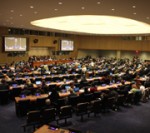
Current and future population trends and their implications for sustainable development will be the focus of the 48th session of the United Nations Commission on Population and Development, to be held at UN Headquarters from 13 to 17 April.
Between 2015 and 2030 the world’s population is projected to grow from 7.3 billion to 8.4 billion, adding about 73 million people to the planet every year. With the exception of Europe, where total population is projected to decrease by slightly less than one per cent by 2030, all other regions are projected to grow by ten per cent or more.
The projected growth of the world’s population to 8.4 billion in 2030 will require countries to plan ahead and develop policies to provide access to resources for growing numbers of people, if they wish to eradicate poverty, reduce social and economic inequality, and end unsustainable patterns of consumption and production, while safeguarding the environment.
This session of the Commission takes place at a critical time, when the world is seeking to forge both a set of sustainable development goals and a meaningful new universal climate agreement. In his opening remarks to the Commission, the Secretary-General said that “these twin priorities will be influenced by the profound demographic shifts taking place in our world, especially those related to youth, the elderly, urbanization and migration.”
Report identifies major population shifts
The thematic report of the Secretary-General prepared on the special theme of this year’s Commission describes the challenges posed by current and future major population trends, as well as the diversity of country and regional experiences. The report highlights in particular the changes that are expected to contribute to or hinder achievement of the future sustainable development goals. While there is uncertainty, for example, regarding the rate of transformation needed to reduce humanity’s environmental footprint, changes in population size, composition and spatial distribution in the near future are more certain.
Over the next 15 years, more than two billion babies are projected to be born worldwide, and countries with the highest rates of child mortality are projected to have the largest increase in total births. A growing number of births poses particularly significant challenges for low-income countries striving to expand services for mothers and newborns.
Between 2015 and 2030, roughly two billion children will reach school age, and 1.9 billion youth will turn 15 years old. Africa can expect a 34 per cent increase in the number of five‑year‑olds, Oceania a 16 per cent increase, and Northern America a ten per cent increase. In Europe, the number of five‑year‑olds is expected to increase by only three per cent, while in Latin America and the Caribbean it is projected to decline by six per cent. Young people represent the promise of the future, but only if their rights are secured and they receive the right start in life, including access to health care, education, and decent work.
Older persons, those aged 60 or over, are now the world’s fastest growing age group. The share of older persons in the population is projected to increase from 12 per cent in 2015 to 16 per cent in 2030. Although the proportion of older people is increasing most in Europe and Northern America, it is expected to increase in all geographic areas over the next 15 years.
All of the 1.1 billion projected growth in global population will occur in urban areas. With the exception of Europe, all regions are projected to record increases of 15 per cent or more in the size of their urban populations. Africa and Asia are expected to have the largest increases in urban populations.
Over the next 15 years the world will also become more mobile, with an additional 30 million international migrants, if current trends continue. While international migration between continents receives much attention, most international migrants move over shorter distances. Whereas Northern America and Oceania draw most of their international migrants from other regions, the majority of migrants in Africa, Asia, Europe and Latin America and the Caribbean reside in the region where they were born.
Commission to focus on future population change and sustainable development
During the upcoming session of the Commission on Population and Development, representatives and experts from UN Member States, various UN entities and civil society will have the opportunity to review this unprecedented change and diversity in global population. In considering the theme of the session, “Integrating population issues into sustainable development, including in the post-2015 development agenda,” they will also make recommendations for the design and implementation of people-centred development strategies aimed at creating a better tomorrow for people and the planet. These discussions and recommendations will contribute to ongoing negotiations on the future post-2015 development agenda, expected to be adopted in September 2015.
